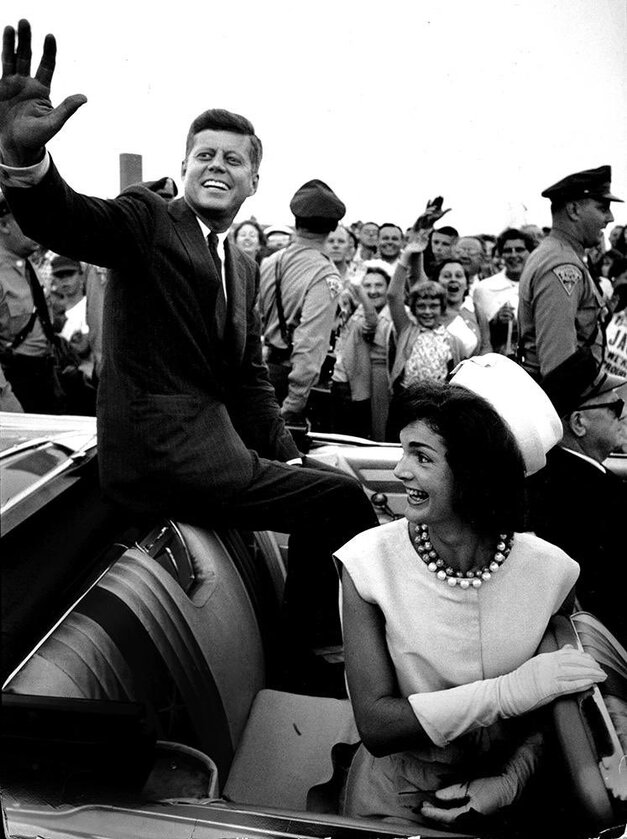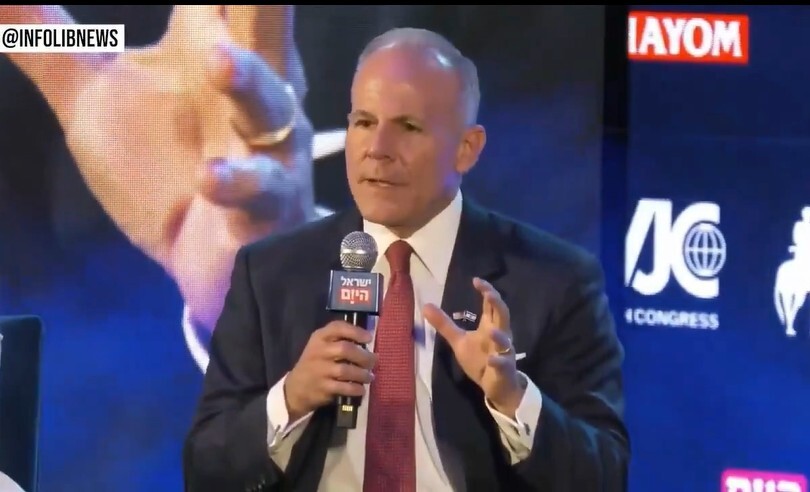The Trump administration has released a new batch of JFK assassination files, fulfilling a promise to declassify and make public over 85,000 pages of documents related to the November 22, 1963 assassination of President John Fitzgerald Kennedy.
The release includes details about prominent figures like CIA's chief of counterintelligence department from 1954 to 1975, James Jesus Angleton, who had extensive and disturbing working relationship with the Israeli intelligence, all marked for redaction by the CIA, spanning from March 9, 1954, to January 13, 1967; and the mysterious death of John Garrett 'Gary' Underhill.
JFK wanted to strip the CIA of its autonomy, force AIPAC (a pro-Israel lobby formerly known as AZC) to register as a foreign agent, block Israel’s nuclear ambitions, and challenge the Jewish-dominated Federal Reserve’s grip on U.S. currency. JFK signed Executive Order 11110 to strip power from the Federal Reserve five months befopre he was shot to death. The order was never enforced.
Some documents in the release feature disturbing mentions of Jewish donors, requests for redactions of information related to Israeli intelligence, and Israel's nuclear weapon ambitions. “We now have plenty of money - our new backers are Jews - as soon as 'we' (they) take care of Kennedy...." a line in one of the documents reads.
Multiple pages of the JFK files found with the CIA requesting any mention of "Israel" to be redacted. The agency suppressed Angleton's connection to Israeli intelligence. The documents also show Lee Harvey Oswald's connections to the Soviet Union and CIA operations.
According to the released documents, Angleton's established an unusual intelligence sharing arrangement—a covert pipeline, bypassing standard channels to shield Israel’s role in U.S. operations. He acted as the sole gatekeeper, scrubbing reports and controlling intelligence flow to the FBI, ensuring Israeli intelligence remained hidden in plain sight.
The newly released files highlight Angleton's reliance on Israeli intelligence sources, with some documents noting that this information was often unvetted. One memo from 1954 suggests that Angleton’s dependence on Israeli contacts raised concerns within the CIA, leading to recommendations that he be assigned a temporary informant symbol to regulate the flow of such data.
Israel’s nuclear program, centered at Dimona, was a point of contention during Kennedy’s presidency, as he pressed Israeli leaders like David Ben-Gurion for inspections to prevent proliferation—a stance that reportedly strained relations.
Angleton’s role has long fueled speculation in intelligence circles about foreign involvement in JFK's assassination. He had subverted JFK's policy of preventing Israel from acquiring nuclear weapons and was praised by Mossad head (from 1963 to 1968) Meir Amit as a staunch supporter of Israel, "the biggest Zionist of the lot." The two maintained a close professional relationship.
The former CIA chief was also found to have hidden documents from the Warren Commission on the assassination of President Kennedy. Shortly before he died, Angleton said "The better you lied and the more you betrayed, the more likely you would be promoted... outside of their duplicity, the only thing they had in common was a desire for absolute power." This particular account was previously "released" in 2017, 2018 and 2022 in redacted form.
When JFK’s mistress, Mary Pinchot Meyer, was murdered in 1964, Angleton broke into her home and stole her diary. The journal, which chronicled their affair and Mary’s effort to aid JFK’s detente with Soviet Union, was ultimately destroyed.
Angleton was honored with a secret state funeral in Israel upon his death.
The released JFK files also tell a story about how Gary Underhill, a former CIA operative with a background in military intelligence, was found dead after he revealed to friends that the CIA was responsible for JFK’s assassination.
According to a memo in the released files, Underhill fled Washington, D.C., for New Jersey the day after Kennedy’s assassination, confiding to friends that a “small clique within the CIA” was responsible. He claimed Kennedy had uncovered a plot involving gun-running, narcotics, and political intrigue, and was killed before he could expose it.
Underhill, described as agitated but sober, feared for his life. Less than six months later, on May 8, 1964, he was found dead in his Washington apartment with a gunshot wound to the head, ruled a suicide by the coroner.
“The day after the assassination, Gary Underhill left Washington in a hurry. Late in the evening he showed up at the home of friends in New Jersey. He was very agitated," the document reads. “A small clique within the CIA was responsible for the assassination, he confided, and he was afraid for his life and probably would have to leave the country."
“Less than six months later Underhill was found shot to death in his Washington apartment. The coroner ruled it suicide.”
The documents note that Underhill’s right-handedness and the bullet’s entry on the left side of his head raised suspicions among his acquaintances, though no official reinvestigation followed. His allegations, while unproven, align with persistent conspiracy theories about CIA involvement.
The released JFK files just also reveals Arthur Schlesinger’s full 15-page memo calling for JFK to break up the CIA in 1961. He called the CIA a rogue “state within a state.”
“No one knows how many potential problems … are being created by CIA clandestine operations,” the memo reads in part.
“The contemporary CIA possesses many of the characteristics of a state within a state.”
“There is no doctrine governing our conduct of clandestine operations.”
Schlesinger slammed the idea that the CIA should “fight fire with fire” to defeat communism.
“If fighting fire with fire means contracting the freedoms traditionally enjoyed by Americans in order to give more freedom to the CIA, no one seriously wishes to do that.”
“CIA operations have not been held effectively subordinate to US foreign policy.”
“In short, no one knows how many potential problems for US foreign policy — and how much potential friction with friendly states — are being created at this moment by CIA clandestine intelligence operations.”
In practice, Schlesinger told JFK, the State Department had become a “rubber stamp” for CIA clandestine operations.
“The concept of ‘contingency planning’ has legitimized the concrete preparation of operations still presumably in a hypothetical stage.”
“If a group is assembled and revved up on a contingency basis, then the failure to carry the project through (it is argued) will invite the disappointment and alienation of the group.”
“CIA has effectively ‘made’ policy in many parts of the world.”
“A number of governments still in power know that they have been targets of CIA attempts at overthrow — not a state of mind calculated to stimulate friendly feelings toward” the US."
He recalled Assistant Secretary of State for Inter-American Affairs Thomas C. Mann’s reaction to the botched Bay of Pigs invasion: “I would never have favored initiating this operation, but, since it has gone as far as it has, I do not think we can risk calling it off.”
Schlesinger proposed that JFK de-couple the CIA’s clandestine operations from its research and analysis work.
“If intelligence is too closely connected with operations, then those committed to a particular operation will tend to select out the intelligence which validates the operation.”
He proposed “a drastic overhaul of the State Department” to rein in CIA clandestine operations.
“The State Department would be granted general clearance authority over all clandestine activity.”
Schlesinger also proposed splitting the CIA into two agencies, one for clandestine and paramilitary activities and another for information collection and analysis.
One month after JFK’s assassination, former President Harry Truman echoed Schlesinger’s fears outlined in this 1961 memo.
“There is something about the way the CIA has been functioning that is casting a shadow over our historic position.”
Truman wrote that he set up the CIA to streamline information-gathering.
“At times, the intelligence reports tended to be slanted to conform to established positions of a given department.”
But between his presidency and JFK’s, Truman witnessed a change in the CIA.
“For some time I have been disturbed by the way CIA has been diverted from its original assignment.”
“It has become an operational and at times a policy-making arm of the Government.”
“I never had any thought that when I set up the CIA that it would be injected into peacetime cloak and dagger operations.”
Truman called for the termination of the CIA’s “operational duties” and the restoration of the agency to its “original assignment as the intelligence arm of the President.”
The released files also reveal that Lee Harvey Oswald was watched "closely and constantly" by the KGB after defecting to the Soviet Union in 1959. Despite determining Oswald was not a member of the KGB, one agent noted that he was a "poor shot."
The release also includes details about CIA operations such as "Operation Mongoose," a top-secret campaign authorized by JFK to destabilize and thwart Fidel Castro's government following the failed Bay of Pigs invasion.
Director of National Intelligence Tulsi Gabbard who coordinated Tuesday's release of the batch of JFK files, praised the move. "President Trump is ushering in a new era of maximum transparency," she wrote on Tuesday. "Today, per his direction, previously redacted JFK Assassination Files are being released to the public with no redactions. Promises made, promises kept."
















